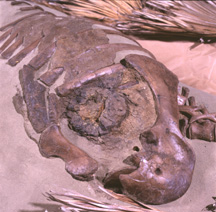A dinosaur's tell-tale heart

Artist's rendition of a Thescelosaur, a plant-eating dinosaur. Illustration by Ed Heck.
| Geotimes Home | Calendar | Classifieds | Advertise | Subscribe |
| Geotimes
Published by the American Geological Institute |
Newsmagazine of the Earth Sciences
June 2000 |
| Paleontology
A dinosaur's tell-tale heart
|

Artist's rendition of a Thescelosaur, a plant-eating dinosaur. Illustration by Ed Heck. |
Paleontologists are antsy to see first-hand the recently reported heart of a dinosaur. The reddish-brown stone sits like a grapefruit-sized jewel in the chest cavity of a 66-million-year-old dinosaur at the North Carolina Museum of Natural History. But it is a curiosity; no one is really sure how it was preserved.
In 1993, the Thescelosaur dinosaur skeleton sparked excitement over
its complete skull, the first find of its kind, says Michael Hammer, an
independent fossil collector from Oregon whose son found the dinosaur.
Heavy rains had exposed four cervical vertebrates from sandstone of the
Hell Creek Formation in Harding County, in northwestern South Dakota. Hammer
bandaged the dinosaur, nicknamed Willo after the landowner’s wife, in four
parts and only later, when it came time to unwrap the thorax jacket, did
he find the concretion in the chest cavity. “I thought it had to be the
heart, or the result of the heart being there,” Hammer says.

How this dinosaur's heart turned to stone is anyone's guess. Goethite, a mineral formed by the oxidation of iron- rich deposits, may be a clue. Jim Page, North Carolina Museum of Natural Sciences. |
The researchers studying the iron concretion expected it might be similar
to a crocodile heart. But computerized tomography (C.T.) imagery scans
revealed a heart more similar to that of a bird or mammal rather than a
reptile. This was unexpected because the dinosaur was not from the lineage
of theropods thought to be the ancestors of birds. Willo was a plant-eating
ornithischian.
“It was as much a surprise to us as it’s been to any other scientist
since,” says Paul E. Fisher, director of North Carolina State University’s
Biomedical Imaging Resource Facility and lead author on the report, which
appeared in the April 21 Science. The team of researchers identified the
remnants of two-and-a-half-chambers, indicating a four-chambered heart,
and a single systemic aorta, similar to that of endothermic mammals and
birds. A cold-blooded crocodile also has a four-chambered heart, but a
second aortic arch and incompletely separated ventricles give it a less
efficient means of supporting a high metabolic rate.
|
Besides Fisher, the research team included Dale A. Russell of the North Carolina Museum of Natural Sciences in Raleigh; comparative anatomist Michael Stoskopf and paleobiologist Reese Barrick, both at North Carolina State; paleontological investigator Michael Hammer; and Andrew A. Kuzmitz, a physician in Ashland, Ore., who, after examining the fossil with C.T. scans, invited seven cardiologists to view the images. The specialists all agreed that the images showed a heart with two large, oval chambers, or ventricles, divided by a septum.
How can a heart be fossilized in a sanstone environment? Although the researchers reported “the geochemical processes involved have not been well studied,” they suggested that a process called saponification — whereby soft tissues turn soapy in wet, anoxic conditions and then harden — preserved the heart. Fisher described the hypothesis as conjecture. “We don’t know why or how this happened,” he says. “We need input from the community; we’re open to anything.”
Indeed, saponification usually occurs with mostly fatty tissue, says Ken Carpenter, dinosaur paleontologist at the Denver Museum of Natural History. “High amounts of calcium carbonate in groundwater react with fatty tissue to create a natural soap,” he says. “With the heart, you are more likely to get a fossil because of muscle, decay-resistant tissue.” Within a few hours of death the blood cells begin to break down. The intestines are the first to start to decompose and then the liver, he says.
Fisher and colleagues reported an abundance of the mineral goethite in the ventricle walls of the heart but not in the surrounding sediments or bones. If the animal was buried quickly then aerobic bacteria would soon consume oxygen in the body cavity and blood, Carpenter says.
Bacteria that could survive without oxygen would replace the aerobic bacteria and begin to thrive on the remaining tissue and produce waste products. The dissolved minerals from the groundwater and the iron from the blood may have provided the anaerobic bacteria a catalyst for eliminating their waste and precipitating out goethite, Carpenter says. In the process the bacteria entomb themselves in a film that mineralizes the bones and even the soft tissue, he says.
“The heart is a thick-walled, muscular organ and there is more structure to it to remain intact,” Fisher says. “But the liver or kidney certainly could still be there. We concentrated our study on the thorax and another concretion was found in the lower part of the belly by one of the hind legs.” The team plans to scan the thorax again at a higher resolution and investigate the rest of the fossil for other internal organs.
Christina Reed
More information on the heart and Willo can be
found at www.dinoheart.org.
 |
Geotimes Home | AGI Home | Information Services | Geoscience Education | Public Policy | Programs | Publications | Careers |